By John Paul Caponigro
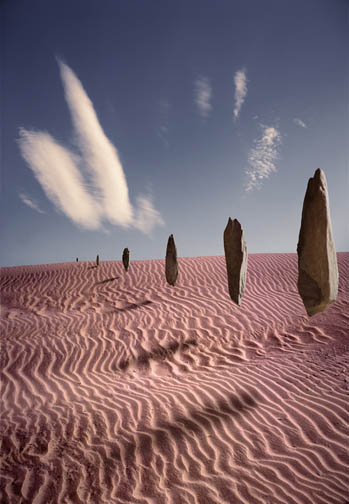
Why Write About Composition?
Why write about composition? Because I’ve had countless requests to do so. There seems to be a real hunger for it. Over the years my students have asked me for good resources on composition. They’re looking for something sophisticated but not overly complex and ultimately practical. There are many good sources on composition for painters and designers. There are few good references written specifically for the photographer. While the fundamental principles of design are the same for all visual artists (and that means the concepts and resources produced for disciplines other than photography will also be insightful for the photographer), there are specific photographic considerations concerning both production and delivery that exert a strong modifying effect on both perception and application for the photographer and ultimately reception by their audiences.
Books on design can often be so abstract that it is unclear for the photographer how relevant the examples are, much less how to apply them. It is my hope that readers of this material will quickly see the relevance of abstract thinking and discover ways of applying abstract thought to more complex photographic processes and information.
The limitations of photography strongly influence the ways photographers approach making photographs and how they conceptualize what photographs are, frequently in too limited a fashion. Every discipline offers a set of limitations, which are accepted and exploited if mastery is achieved. For instance, it’s challenging to render detail with painting, it’s challenging not to render it with photography.
Digital imaging calls all the previous limitations into question. There are fewer limits and more possibilities. That means we can produce photographs in many more ways. And this in turn means we can make many more kinds of photographic statements. There’s never been a better time for a discussion of photographic composition.
______________________________________________________________
Defining Composition
How do you define something? One classic strategy is to let the dictionary define it for you. The Oxford English Dictionary defines composition in the following ways …
… the act of combining; forming relationships (between things); synthesis; reasoning from the universal to the particular; combining arithmetical factors, ratios, forces, elements to produce a compound; chemical combination; combining words and sentences to produce a literary work; combining sounds to produce a musical work; settling differences or an agreement; arrangement; constitution of mind and/or body or both; a creation shared by individual parts; union; aggregate; mixture; structure; design …
This paraphrases a more than one page definition. Reproducing the full version would be tedious. But I recommend you take a glance at the full definition to get a sense of how wide ranging the many definitions contained in this one entry are, which are used by many disciplines yet still related.
For the visual artist we could settle on a working definition, a simple statement that could be useful. Composition is the act of combining graphic elements to create a visual structure or it’s the product generated by this act. That suffices. That’s useful. But, while it’s useful to settle this, it would also be useful not to settle this issue definitively. The tension set up by continuing to consider all of the ambiguities, contradictions, connections, and unanswered questions will lead to some marvelous insights. For this very reason, I recommend you settle on your own working definition. And then continue to refine it. Because, rather than settling it definitively, by continuing to work with the question you’ll benefit even more.
______________________________________________________________
Isolate the Variables
Composition is everything. It involves all the physical elements we see when looking at images. Some of the elements of design include point, line, plane, shape, size, volume, color, and texture. It’s interesting to consider whether other dimensions exist in and of themselves or are they instead produced by a relationship of already existing elements, such as position, space, and orientation. Some important dimensions may even arise through psychological attributions, such as weight.
Composition can become so overwhelmingly complex it becomes hard to grapple with. But we can make this task manageable. Isolate each element. Study it. Practice it. Understand it thoroughly. Then begin to explore the relationship each element has to other elements of composition; how it impacts and is impacted by other factors.
Exploring how each of these elements interacts with and potentially modifies the effects of the others becomes more clear and productive if we first identify the elements involved and how they function on their own. Doing this will increase our sensitivity to all of the elements involved.
Systematic thinking can be very useful. There’s a time and place for it. When studying each element for the first time I recommend you try to be precise and concrete with maximum objectivity and minimum subjectivity. After your initial explorations, I highly recommend you incorporate your personal subjective reactions into your thinking and process. Develop a relationship with your material. Ultimately, while we all deal with the same issues, your relationship to them will be different from others’. The goal is not to solve the problem like a mathematical equation, coming up with the same answer every time, but rather to deepen our understanding of the issues so that we can make our work stronger on every level.
______________________________________________________________
Fundamentals
Often, we take the fundamentals for granted. Having worked with them unconsciously for so long we may miss opportunities to refine and strengthen these aspects of our work with more conscious efforts. It can take distilling visual challenges to their most essential to focus intensely on a single element in order to strengthen it. This work is rewarding for any visual communicator at any stage, whether amateur or master. The complexity and order of activity may vary with development, but the fundamentals of the challenge will remain the same.
______________________________________________________________
Keep It Simple
I’ve tried to keep the text extremely simple. I’ve combined simple language with more visual information. And I encourage you to put these principles into action through exercises. Intellectual understanding is a very different thing than internalizing the information well enough to act on it, sometimes without thinking. I recommend that you keep the language of your thinking on this subject simple too. Simplicity makes things memorable. Simplicity makes things useful. In the sciences simplicity is often seen as a sign of greater probability of correctness and along with this there is often an attempt to move from the particular to more universal principles. The same attitude works well in the arts. Simplicity is very different than taking a simplistic attitude towards things. A simplistic approach can be adopted instantly by taking a casual or even uninterested stance to a subject or issue. On the other hand, it takes a lot of work to make complex subjects simple. And, it takes experience (discovery, action, reaction) to see and feel deeply about things that at first seem simple but ultimately are profound. The ability to do these things is often seen as a sign of mastery.
______________________________________________________________
Principles of Visual Dynamics
An orator can speak more effectively with an understanding of grammatical rules and conventions than without an understanding of them. It’s the same for anyone who makes visual statements. Verbal language is composed of elements, principles, concepts, and conventions. The same can be said of visual language. A designer can work without consciously understanding the foundations of visual language, but his or her work will be stronger with an understanding of them. An understanding of these foundations is not a substitute for either inspiration or passion. When this material is truly understood it enables greater discover of one and expression of the other. It fuels the fires.
If you like rules, remember exceptions prove the rules. Being too insistent on the application of hard and fast rules can blind you to many exceptional opportunities. If you don’t like rules, remember that while there are no absolutes there are forces at work that have consistent tendencies. Denying or ignoring universal principles will lead to unpredictable unrepeatable results; you’ll achieve success far less frequently and be far less able to repeat your successes.
Forget rules. Forget absolutes. Forget musts. Instead develop an awareness of visual principles. Look for the unique power each element has to influence a composition. Develop a sensitivity to how elements and combination of elements make the forces at work in a composition stronger or weaker. Instead of composing formulaically, you’ll then be able to improvise. Understanding the principles of visual dynamics will help make your decision making process more informed, it will not make choices for you. Awareness is the key. Better awareness brings better choices bringing better results.
Composition is an extremely complex subject. In any composition there are many variables at work simultaneously. Each variable exerts its own force, contributing to the whole. Each element influences the other, creating a cascading chain of action, reaction, interaction. The degree to which one variable is emphasized over or used to modify another gives the viewer visual clues about the creator’s ways of seeing and intentions. Visual communicators dynamically combine these components to make statements. Versatility with many strategies enables visual communicators to more successful in varied situations and to make more varied statements. Consistency, strength, and distinctive (sometimes novel) approach indicates a signature style, communicating information not only about the subjects but also about the creator of an image or images. It’s all about the quality of the relationships you create.
______________________________________________________________
Photographic Composition
Photographic composition deals with all of the same elements as any other two-dimensional image making process, but has additional considerations that are specific to the medium. Painters “synthesize” while photographers “select.” The great photographic historian John Szarkowski rendered more clearly an important distinction with respect to photographic composition by this choice of words. Not everything a painter renders in a single composition was before his or her eye at one time and it may not be rendered exactly as seen. The opposite is true for most photographers. Painters can choose to render elements indistinctly or not to render them at all, while photographers must use frame, angle of view, or exposure (brightness or duration) to subdue or eliminate elements. Photographers deal with what can be an overwhelming balance of concerns that extend beyond composition to include time constraints and changing conditions. These fundamental differences alter the relationships between both the author and the image and the image and the viewer. It changes the way images are made; it changes the way images are perceived. It changes everyone’s expectations. (The relatively recent use of digital technology calls these distinctions into question. It can no longer be made as absolutely as it was once asserted.)
Like any art, the art of photography is in many respects the art of compromise. Because photography does so much, because everything within the frame is typically included in the final composition, the compositions it generates are often not ideal. This lack of picture perfectness is often used as a cue to spontaneousness (natural/real) rather than control (staged). Imperfections may be seen as indicators of factual truth (ratification of verisimilitude and veracity). Seen in this light our perspective may change. Perfect composition may not be perfect. Perfection may lie in imperfections. Picture imperfect may be perfectly imperfect. Various genres of photography deal with perfection and imperfection in various ways; all of them deal with it. In the end, this will influence your use of the principles of composition.
______________________________________________________________
Practice
Theory is useful. So’s practice. Both produce different kinds of understanding. When they work in concert with one another better results are produced in both. Better theory leads to better practice. Better practice leads to better theory. With this in mind I’ve designed exercises to stimulate your appreciation of each topic. You’ll find them rewarding. I do.
There will be times when you simply want to practice the exercise, making an image that is insightful solely with regard to the element being explored, rather than making images that are successful in every way. These types of images may seem unsuccessful but nothing could be further from the truth. Though you may not display them as finished products, you may gain a great deal more from these unfinished images than exhibition worthy images that repeat your previous successes. When you’re doing the exercises, concentrate on making images that excel at the one dimension you are focusing on. Make the finished images. But always return to the task at hand. You’ll learn more and in time become more versatile, which will lead to many more successful images in the future. Even masters practice. Remember, practice doesn’t make perfect. Even perfect practice doesn’t make perfect. Nothing is perfect. So let yourself off that hook. Practice makes better. And that’s the goal. Improvement.
This is an online column and that means many things can happen that might not happen in traditional print. The content can be of any length. It can be updated at any time. It can be delivered in many media – text, image, audio, video. And, it can be interactive. I’m going to encourage readers to post their own images which are relevant to the recommended exercises to the Luminous Landscape forums and vote for the images they feel are most successful. I’ll point out images from these community contributions that I think are particularly successful and comment on why I think they’re successful. Links will be provided. Conversation will be stimulated. I hope my material will become a catalyst for material you in turn generate together. I think we’ll all learn many valuable things. Collective distributed nonlocal asynchronous intelligence. It can be a powerful thing. Let the games begin!
______________________________________________________________
Exercise
Reducing Images to The Essentials
You can see the fundamental structures present and visual dynamics at work in your images by reducing the wealth of information found in photographs. You can use Photoshop to do this in countless ways. Here are a few.
• The full color image.

• Filter: Blur : Gaussian Blur displays fields of color.

• Filter : Pixellate : Mosaic displays color blocks.
![]()
• Duplicating the Background layer, applying the filter Blur : Average; and changing the layer blend mode to Luminosity creates a map of hues.
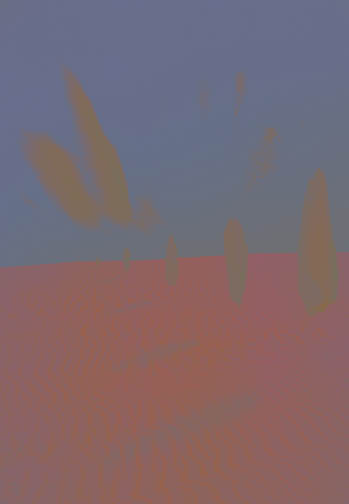
• Desaturating the image shows luminosity without the impact of hue and saturation.
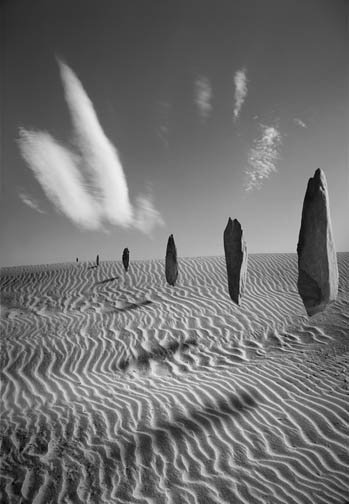
• Image : Adjustments : Threshold reduces the tonal structure to large blocks of black or white and shows texture.

• Filter : Other : High Pass makes contours pronounced.
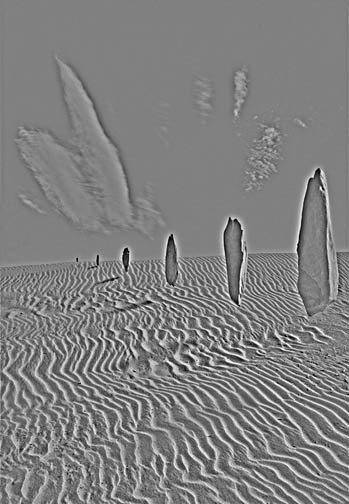
• Filter : Stylize : Emboss makes contours pronounced.
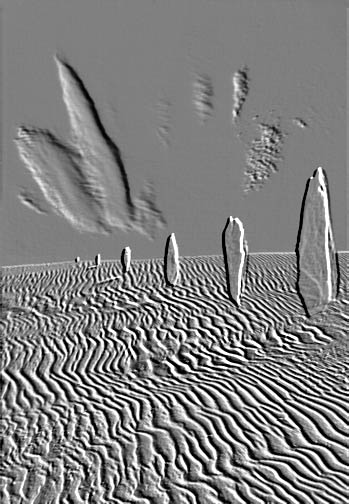
• Filter : Stylize : Find Edges makes contours pronounced.
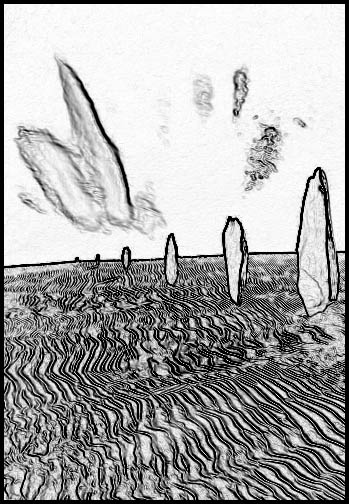
• Contours isolated by tracing simple straight lines drawn on a new layer.
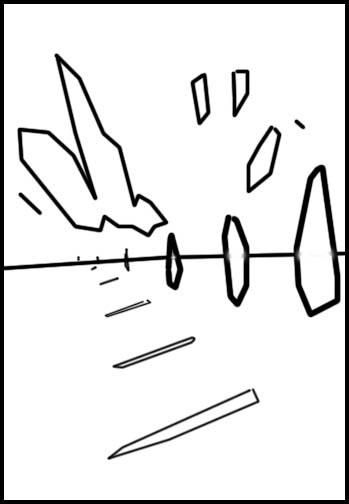
• Directional vectors can be found by tracing simple straight lines down the center of significant elements.
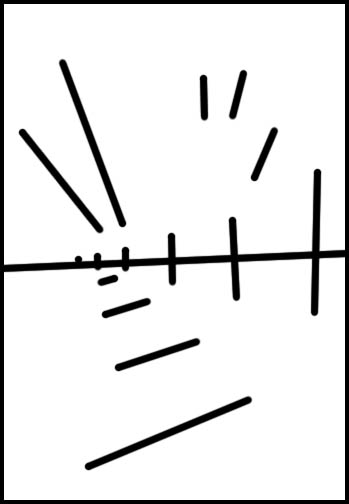
John Paul Caponigro
June, 2009
______________________________________________________________
Learn more atjohnpaulcaponigro.com.
Find workshops, DVDs, books, and much, much more.
Sign up for free enews – Insights. Get over 100 downloads.
You May Also Enjoy...
Taking Your Photography To The Next Level #2
Part Two of a Three Part Series Assessing Your Technical And Aesthetic SkillsWelcome back to part 2 of a three part series on finding your
